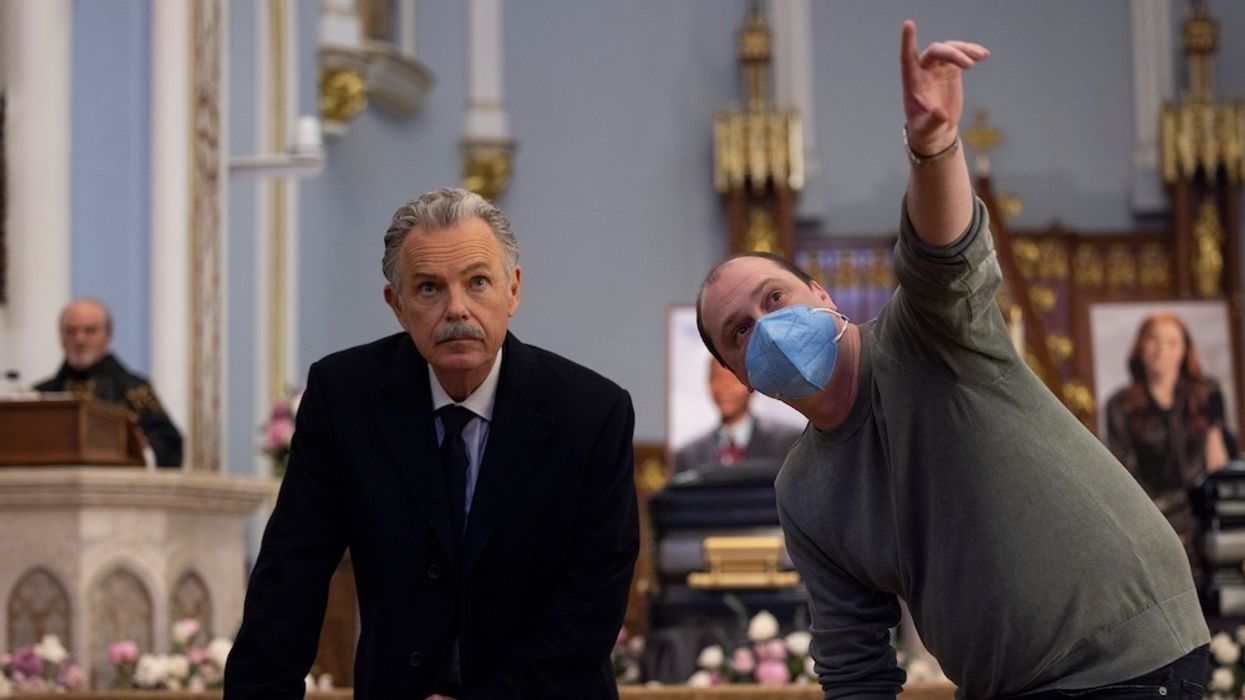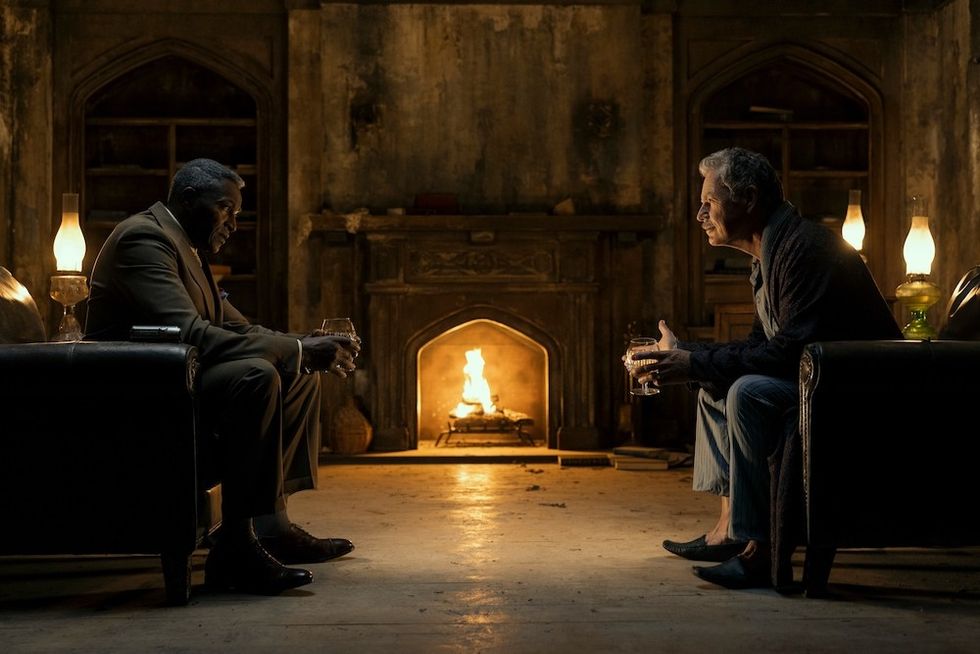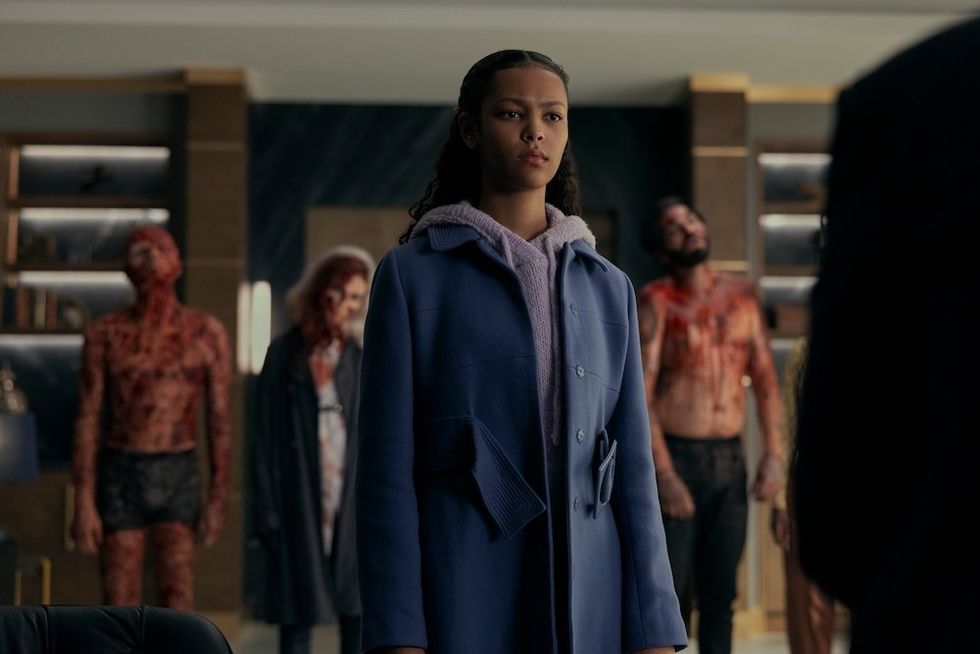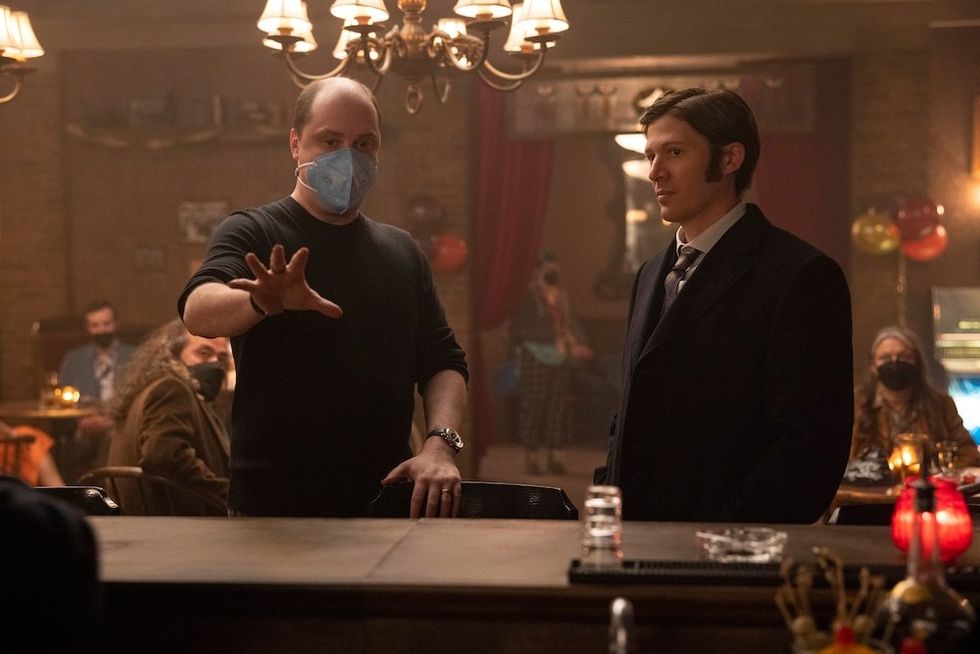Creating Horror Through Sound in 'The Fall of the House of Usher'
No Film School gets symphonic secrets from sound editor Jonathan Wales.

'The Fall of the House of Usher'
Jonathan Wales is the co-supervising sound editor, re-recording mixer, and scoring mixer of the new Netflix show The Fall of the House of Usher. He's worked in the sound department of several impressive projects, especially in the horror genre—he was on the team for Get Out, The Black Phone, The Mist, as well as many Mike Flanagan projects like The Haunting of Hill House and Doctor Sleep.
Inspired by the words of Edgar Allan Poe, Usher is like Succession put through a horror filter. It follows the filthy rich Usher family, which made its money through pharmaceuticals and, it turns out, nefarious means. The show is the final in the partnership between iconic horror writer/director Flanagan and Netflix, and it's a strong farewell, for sure.
You'd be right if you assumed that sound plays a huge part in a show that offers new versions of "The Tell-Tale Heart" and "The Murders in the Rue Morgue," so we were excited to learn about Wales' process on the sound team.
We spoke to him via Zoom to learn the secrets of the Usher family. Enjoy.
The Fall of the House of Usher | Official Trailer | Netflixwww.youtube.com
How sound is unique in the horror of Usher
The horror genre is a space for experimentation at all levels, but sound can be especially important here to set the scenes and play with what the audience is experiencing.
Wales said that this room for creativity is one thing that excites him about the genre.
"There are some genres in film where you really get to play around a lot more with sound, horror being one of them, sci-fi, high fantasy being another one ... " he said. "And when it's horror, you're trying to maybe deal with, well, 'What is that person's experience with this thing that is happening to them that's kind of messed up?'"
But even in the middle of experimentation, the sound has to serve the story above all.
"We can make a lot of noise and do a lot of stuff; if it doesn't help the story, then it's distracting and weird and not good," he said.
In the case of The Fall of the House of Usher, a key sequence throughout the show is Roderick Usher (Bruce Greenwood) telling his family's story to lawyer C. Auguste Dupin (Carl Lumbly) in his childhood home, which is falling down around them as a storm builds in each episode. A fireplace is one of the only other sources of sound in that location.
"I'm always playing with how the voices react in the space," Wales said. "Especially in this show, actually, I did a lot of work with the same characters in different rooms, how their voices react with the room. So that house has a particular identity every time you're there. You know you're there from how it sounds.
"If you're in the glass conference room, for instance, you know you're in there from how it sounds, or if you're in Freddy's house, you know how it sounds from being there. I was trying very hard to get those identities to really feel consistent so that it gave a sound backdrop just from the way the dialogue sounds to each of those environments."
Sometimes, in Usher, the important element of Wales' work was the absence of sound.
"In a lot of the other rooms, especially in the modern office building, we were trying to be very sterile," Wales said. "The whole notion of they're in an ivory tower, they're very divorced from the world around them, so we don't really hear anything from outside. And it's sort of got this low, just slightly ominous air conditioning vibe, but very little else. There's no life to it. We don't have other people in that office. We don't have phones ringing, we don't do any of that stuff that you might expect. And that gives it its own sort of isolation. Which is very difficult, actually, because then there's nothing to hide behind ever if anything's not right."

Creating Sounds Inspired by Edgar Allan Poe
If you think about Poe's work, you probably have some pretty iconic imagery in mind—a raven, a heart beating under floorboards, bells tolling, a pendulum swinging. So how did the creators of Usher take some of these iconic Gothic sounds and give them a unique, modern spin?
"We really did get to play with that a bit, because we're dealing with unseen characters," Wales said. 'The Tell-Tale Heart,' especially, is something that really doesn't actually physically exist until the very, very end. And so you have this concept of an unseen object, that is really a sound-only construction, that is a full-on character in the show. Everything about the way T'Nia [Miller's] acting, in terms of her reactions to it and everything ... It's like a character."
They also had to figure out how to treat the sound in the scene as it related to reality.
"Sometimes we allow the audience to believe maybe it is real and maybe we're hearing it as well, maybe it really is over there, to the left or whatever," he said. "Especially in the early part. We were playing with making it feel like, 'Well, maybe it is diegetic. Oh no, it's actually not. It's actually something that she's hearing that the other characters can't hear.'"
The sound of this element started to come together in the edit process with Mike Flanagan.
"There's so much rhythm to how that reacts with the acting, and our job was then to take that and flesh it out even further, to really turn it into character," Wales said. "It's very interactive with the dialogue, because you have these places where, 'Is she hearing something?' She's having a conversation with, say, Verna Carla [Gugino], but she's hearing this heart, and then all the voice perspectives start changing. And that stuff's tough, because you want to make sure you can still hear every word that they're saying, even though you're messing with the words. And a lot of the process there is to find out how far is too far."
Pushing the limits is not a new concept in filmmaking. If you look through the advice scattered throughout NFS, you'll see that creative after creative advise that it's usually better to go too far rather than be timid. You can always tone down the writing, take pieces of costuming or set dressing away, or in this case, edit down sound.
"I do this a lot with Mike," Wales said. "We'll take something too far and then we'll dial it back a bit. Because until you really know how far you can go, you haven't fully figured it out.
"So we do that, we make things that are too big and then, or we make backgrounds that are too complex, and then we take elements back out as part of the way of figuring out what's important and isn't."

The Most Challenging Sounds of Usher
Every scene and episode obviously present unique challenges, but what were those sequences in Usher? (Spoilers below.)
He pointed to the scene where Roderick Usher pondered possible suicide, as well as the finale sequence in the last episode, as difficult bits of work requiring balance and care.
"And then you have the scene with Verna in the office, when they're looking out at all the bodies falling down," Wales said. "There was a lot of, 'Well, do these bodies make a noise? If they do, what is it?' And again, I think in a lot of places like that, you go for things that are more of a feeling than a thing. We want the feeling of what that is to be more important than the literality of it.
"So Trevor [Gates], the sound designer, created all of these individual sounds of like, 'Well, what does it feel like if the body rushes by the window outside?' And we were layering those up, and obviously again, there's a lot of score, and it's all raining and there's thunder.
"And so I think it's like, how do we create that tension and still give the acting room to be what matters? Because ultimately, the whole scene is still about a conversation between two people."
Despite the complexity of these sequences, however, Wales emphasized that in most cases, the focus of these scenes should still be the conversations happening between whichever two characters are on the screen.
Wales praised the performances of several actors in the show, including Carla Gugino, who made his job easier.
"Carla is just so miraculous in what she's able to do. Also, not just with her acting, but with her voice and how you can't ever not pay attention to a hundred percent of what she says, just because she has you in that spell that she has. And part of the trick is never to do anything that takes away from them. Only ever to enhance, but never to take away from the story."

Advice from Wales for Stronger Sound
"I think the number-one piece of advice is you cannot be scared to experiment," Wales said. "I think sometimes people fall into a trap of thinking that somehow we just know what we're doing. And over time, you learn a few things, but the one thing you should never unlearn is that you should just try things.
"Very often, it's the things you don't expect to work in your mind that end up being sometimes the coolest ideas. So never don't try an idea. Don't think yourself out of a good idea, just try it. It might be great, it might be terrible, but you are never going to find that out until you allow yourself to just experiment. And it's okay to overdo it, as long as you go back and edit your way back out of it. In other words, you don't want to completely just throw things at the wall and see what sticks, but it's very helpful to discover how much is too much."
Wales hinted at the ultimate job of sound editors, which is to support the story and do their best to not be a distraction.
"And usually, that's the thing you have to sort of teach yourself, is 'At what point am I no longer watching the story and I'm just more watching a bunch of things happen, or a bunch of noise?'"
Sound, he said, is also not there to dictate.
"We're not creating the emotion," he said. "The emotion is there in the performances. But we're trying to see what we can do to help it."
He referenced one key scene near the end of the show, when Verna has to come to Lenore (Kyliegh Curran) to gently end her life.
"What is that scene? It is one person talking to another, just sitting on a bed," Wales said. "It's in the middle of all this stuff, and it's a frighteningly terrifying thing, because you really effectively already know what's happening and you know what's going to happen. You know that this is curtains for her, and yet ... What do we do? We play very subtle, but very emotionally, musically against it.
"So now it's really all of the what could have been and what does happen, and then she dies. And it's all in the acting. You could turn everything off and just listen to the words and it's all there. And so it's like, 'How do we not screw that up? How do we bring the audience along, but we don't take away from what's in their acting lines?'"
The scene is extremely emotional, drawing tears from many viewers (including this writer). How do you know if something is working? If it's an emotional scene like that one, Wales said, it should affect you just as much on every viewing.
"That means you're winning," he said.
Wales also advised, wisely, that "perfect is the enemy of the really good" and that you have to be satisfied with your work at some point.
"I've had too many times where you get somewhere good, and then you try and keep going and keep going and keep going, because, 'Well, maybe it can be even better,'" he said. "And then at some point, you lose track of what was good. And then, if you're smart about it, you eventually figure that out and go back to when you remember it was good.
"You really can try too hard. Less is often more, and the perfect is very often the enemy of the good."
The Fall of the House of Usher is now streaming on Netflix.

 "'Back Home"via Mercedes Arutro
"'Back Home"via Mercedes Arutro 'Back Home'via Mercedes Arutro
'Back Home'via Mercedes Arutro 









